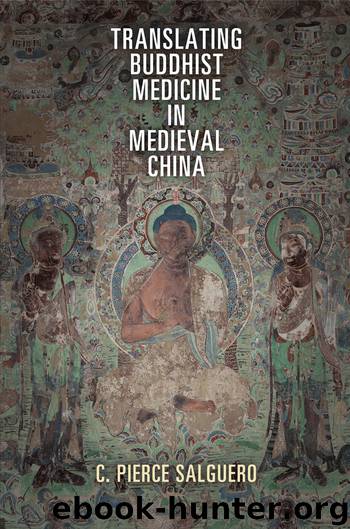Translating Buddhist Medicine in Medieval China by Salguero C. Pierce;

Author:Salguero, C. Pierce;
Language: eng
Format: epub
Publisher: University of Pennsylvania Press
The authors of the texts discussed in this chapter exhibited different attitudes toward Indian medical knowledge, forwarded divergent interpretations of its core doctrines, and took distinct stances on how it should be represented in the Chinese cultural context. These examples demonstrate that how medieval Chinese rewriters approached the task of translating Buddhist medical doctrines could vary widely—even on the part of a single author when writing for different audiences. They also show how closely translation strategies were connected with the historical contexts, intellectual milieus, and social goals of the translators.
This chapter has described the deepening engagement of Chinese Buddhist authors with Indian medicine between the sixth and eighth centuries, which I have suggested is related to the contemporaneous consolidation and stabilization of the reunified empire and the strengthening of Indo-Sinitic economic and political contacts. Ironically, however, the turn away from the use of metaphorical equivalence and domesticating translations is likely to have contributed in the long term to a decline in the importance of Indian medical doctrines in Chinese thought. Buddhist authors’ increasing engagement with the source context would have greatly enhanced the specialized reader’s familiarity with a range of Indian doctrines; however, as discussed in the foregoing chapters, the appeal of Buddhist medical models in broader society was directly related to the accessibility of the texts explaining them and their compatibility with indigenous linguistic and cultural repertoires. An increasingly foreignizing presentation of Buddhist medical knowledge by Tang-era exegetes meant that such doctrines were increasingly bring marked as specialized, non-Chinese knowledge. Over time, learned discussions of Buddhist medicine consequently became accessible to fewer and fewer outside of the most educated among the sangha.
In fact, however, almost all of the texts discussed in this book thus far would have been difficult for ordinary medieval people to understand. Compositions like Huizhao’s would have seemed especially abstruse and unapproachable, but all Buddhist texts strewn with transliterations and other foreignizing terms would have presented interpretive problems. In the next chapter, we will leave aside scriptures written in Buddhist Hybrid Chinese and the theoretical musings of exegetes, sectarians, and philosophers, and turn instead to popular genres of literature. These more accurately reflect the common understandings of Buddhism among everyday people, and provide us the opportunity to explore how aspects of Buddhist medicine were, in time, able to become enduring and vibrant parts of Chinese popular culture.
Download
This site does not store any files on its server. We only index and link to content provided by other sites. Please contact the content providers to delete copyright contents if any and email us, we'll remove relevant links or contents immediately.
| Acupuncture & Acupressure | Aromatherapy |
| Ayurveda | Chelation |
| Chinese Medicine | Energy Healing |
| Healing | Herbal Remedies |
| Holistic | Homeopathy |
| Hypnotherapy | Massage |
| Meditation | Naturopathy |
| Reference |
Inner Engineering: A Yogi's Guide to Joy by Sadhguru(6445)
The Power of Now: A Guide to Spiritual Enlightenment by Eckhart Tolle(5340)
Fear by Osho(4496)
Ikigai by Héctor García & Francesc Miralles(3899)
The Art of Happiness by The Dalai Lama(3850)
The Ultimate Bodybuilding Cookbook by Kendall Lou Schmidt(3710)
Yoga Therapy by Mark Stephens(3577)
The Little Book of Hygge by Meik Wiking(3449)
Why Buddhism is True by Robert Wright(3290)
The Healing Self by Deepak Chopra(3264)
Being Aware of Being Aware by Rupert Spira(3086)
The Hatha Yoga Pradipika (Translated) by Svatmarama(3077)
Shift into Freedom by Loch Kelly(3031)
Wild Words from Wild Women by Stephens Autumn(2939)
Work Clean by Dan Charnas(2896)
Happiness by Matthieu Ricard(2885)
More Language of Letting Go: 366 New Daily Meditations by Melody Beattie(2851)
Yoga Body & Mind Handbook by Jasmine Tarkeshi(2751)
Why I Am Not a Feminist by Jessa Crispin(2587)
